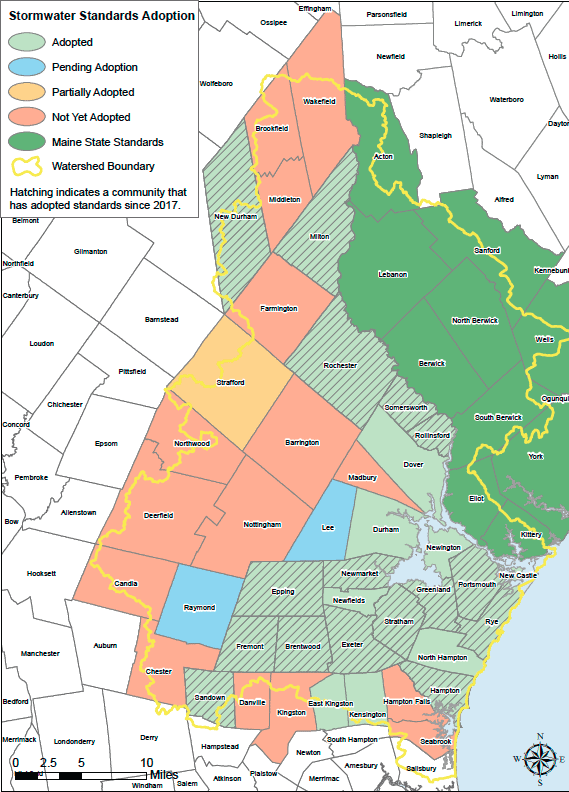Stormwater Management Standards and Funding
Stormwater Management Effort
How many of the 52 communities in the Piscataqua Region Watershed have adopted the Southeast Watershed Alliance Model Stormwater Standards for Coastal Communities or similar standards? Additionally, how many communities in the watershed have adopted a stormwater utility?
As of May 2022, 24 of the 42 (57%) New Hampshire municipalities in the Piscataqua Region Watershed have adopted the complete set of the Southeast Watershed Alliance (SWA) model or similar stormwater management standards, two communities are in the process of adoption, one community has partial or a different set of standards, and 15 communities have not yet adopted stormwater standards. The 10 Maine communities in the watershed adhere to state-level stormwater management regulations. Although there is community interest in exploring alternate stormwater funding mechanisms, currently no communities have adopted or implemented a stormwater utility. Stormwater projects, operations, and maintenance remain funded by a combination of local taxes, property development costs, grants and loans, and fees.4
Successful stormwater infrastructure directs rainfall to a treatment area where water soaks or infiltrates into the soil or, in some cases, to an outfall on a local waterbody. Impervious cover has a negative impact on streams and groundwater supplies and contributes to nutrient loading and pollution runoff into surface waters. Improvements in stormwater infrastructure include approaches to reduce flow and pollution and to increase infiltration. This helps to recharge groundwater supplies, purify water, and slow the rate of water entering streams that might otherwise increase erosion and the risk of flooding.
Adopting local stormwater management standards helps communities balance development while improving existing site conditions and preventing or reducing future water quality impairments. There are also financial benefits and savings for adopting stormwater management regulations early to avoid higher future costs of installing stormwater retrofits to restore impaired waters.5 New Hampshire state statute enables municipalities to adopt regulatory standards for stormwater management projects not captured under state Alteration of Terrain regulations.6 Similarly in Maine, the state stormwater management law provides stormwater management standards for development that communities must implement for projects exceeding one acre of disturbance.7
The SWA model stormwater standards provide a comprehensive and tailorable approach that can be adopted as part of a community’s zoning ordinance or land development regulations. The list below is a summarized version of key components of the SWA Model Stormwater Standards for Coastal Watershed Communities (elements B-D).8 Including these four components in local regulations minimizes further water quality impairments, and in the case of redevelopment, can improve existing conditions.
- Threshold for applicability — Creates a minimum threshold area for disturbance for new development projects that requires full compliance with stormwater standards.
- Performance measures — Improves water quality by requiring the removal of an established percentage of Total Suspended Solids, Total Nitrogen, and Total Phosphorus.
- Groundwater recharge — Promotes use of infiltration practices (groundwater recharge) to reduce runoff caused by a project and replenish groundwater supply.
- Redevelopment criteria — Requires improvements in stormwater management and treatment for redevelopment projects on existing properties.
To assess stormwater management progress across the Piscataqua Region Watershed, PREP monitors which municipalities have adopted enhanced stormwater standards. As of May 2022, the SWA model or similar stormwater standards has been adopted by 24 communities, one community has adopted a partial set of the recommended regulations without redevelopment standards, two communities have regulations pending, and 15 communities have not yet adopted stormwater regulations (Figure 3.1). Overall, 35 out of 52 communities in the Piscataqua Region Watershed have adopted some level of stormwater standards including the 10 Maine communities in the watershed that adhere to Maine state standards. This represents an increase of 16 communities (31%) that have adopted enhanced stormwater management standards since 2017.
Local stormwater management standards are a step toward reducing non-point source pollution and better managing stormwater in a community. Regulations alone will not solve all water quality concerns and flooding, but enforcement of these standards is key to seeing improvements on the ground. The model stormwater standards also only address new and redevelopment and not existing impervious surfaces. Communities can begin to address existing impervious cover on both public and private land by establishing a dedicated stormwater funding mechanism like a stormwater utility.
Stormwater utilities generate dedicated funding for stormwater management through user fees that are often based on a property’s impervious area.9,10 Fees based on impervious surface area can incentivize green infrastructure and the reduction of impervious surfaces by property owners, further improving water quality and alleviating flooding. This dedicated funding can also be used to maintain or upgrade existing stormwater infrastructure like catch basins and outfalls, develop drainage plans, construct flood control measures, and enhance water quality programs. In addition to providing a dedicated funding source, stormwater utilities can improve the equity of funding stormwater management by basing the fee on impervious surface area rather than property value in cases where property taxes are used to generate stormwater funding.
More than 2,000 communities across the country implement a user or service-based fee program to fund stormwater management and flood resilience programs.11 Currently, none of the 52 communities in the Piscataqua Region Watershed have adopted stormwater utilities; however, several communities are exploring the possibilities. In August 2020, the City of Dover established the Ad Hoc Committee to Study Stormwater and Flood Resilience Funding (Committee) to investigate, study, identify, and make recommendations to the City Council concerning various funding opportunities with respect to existing needs and future stormwater and flood resilience management planning. In January 2022, the Committee voted unanimously to recommend the City of Dover pursue establishment of a Stormwater and Flood Resilience Utility with considerations for crediting to offer rate payers the opportunity to reduce their fee by making site improvements that reduce stormwater runoff and/or improve the water quality of stormwater runoff from their property. Other communities, including Rochester and Portsmouth, have expressed interest in exploring stormwater funding mechanisms/utilities.
Acknowledgments and Credits
Nathaniel Gruen (PREP/UNH) and Abigail Lyon (PREP) with contributions from Fay Rubin (PREP)
